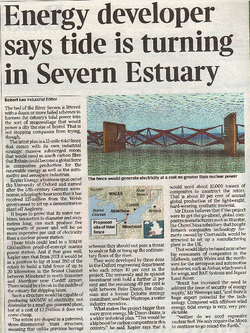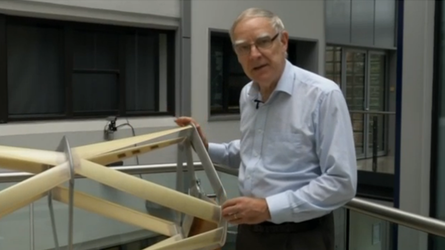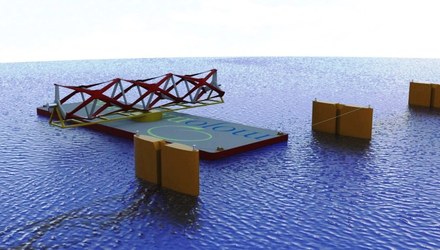
The Times of London publishes article about Kepler Energy's plans for its Tidal Fence proposal and its relevance to the UK's Industrial Strategy. Written by Industry Editor Robert Lea on October 17th 2016.

Watch Professor Guy Houlsby and Peter Dixon explain how the Kepler turbine works and what the company plans to do in this Reuters video:
http://uk.reuters.com/article/us-tidal-energy-idUKKCN0QA1IX20150805
(Advert first!)
http://uk.reuters.com/article/us-tidal-energy-idUKKCN0QA1IX20150805
(Advert first!)

Read about Kepler Energy's different approach in this article in Renewable Energy Focus: http://www.renewableenergyfocus.com/view/42606/tidal-power-a-different-perspective/

Professor Guy Houlsby and Dr Christopher Vogel of the Department of Engineering Science have recently had published in the Proceedings of the Institution of Civil Engineers a radical and peer reviewed paper explaining how the so called Betz limit is broken in open channel flows. Most people in the tidal energy business probably believe that the Lanchester Betz limit sets an upper bound to the amount of power that can be extracted from tidal flows - but they would be wrong, because this limit applies to wind turbines, not to tidal turbines where there is a 'free surface'. Here's the summary of the paper, which is titled "The power available to tidal turbines in an open channel flow":
"Linear momentum actuator disc theory is extended to address the power available to a tidal turbine array spanning the cross-section of an open channel flow. A generalised formulation is presented, which relaxes constraints in previous models on the Froude number of the flow and the geometry of the turbine array, and also considers the effects of far-wake mixing on the overall power removed from the flow. In the limiting case of no free surface deformation, the rigid lid model is recovered.
Blockage, the ratio of turbine frontal area to the cross-sectional area of the surrounding flow passage, has the greatest effect on available power, with the peak power coefficient increasing by 55% from 0·60 to 0·93 as the blockage ratio increases from 0·05 to 0·20. A further 3% increase in peak power coefficient is achieved as the Froude number increases from 0·05 to 0·20. The efficiency of energy extraction may be determined relative to the total power extracted from the flow, comprising the power available to the turbines, and the power dissipated in wake mixing. Higher blockage turbines operating at low thrust coefficients are shown to be more efficient than lower blockage turbines."
The paper concludes: ".....The peak power coefficient is strongly related to blockage, and to the Froude number to a lesser extent, increasing significantly above the Betz (1920) limit as the blockage ratio increases. Higher peak power coefficients are achieved as the blockage ratio increases because the head difference that develops in the channel allows a greater thrust to be exerted on the flow......"
"Linear momentum actuator disc theory is extended to address the power available to a tidal turbine array spanning the cross-section of an open channel flow. A generalised formulation is presented, which relaxes constraints in previous models on the Froude number of the flow and the geometry of the turbine array, and also considers the effects of far-wake mixing on the overall power removed from the flow. In the limiting case of no free surface deformation, the rigid lid model is recovered.
Blockage, the ratio of turbine frontal area to the cross-sectional area of the surrounding flow passage, has the greatest effect on available power, with the peak power coefficient increasing by 55% from 0·60 to 0·93 as the blockage ratio increases from 0·05 to 0·20. A further 3% increase in peak power coefficient is achieved as the Froude number increases from 0·05 to 0·20. The efficiency of energy extraction may be determined relative to the total power extracted from the flow, comprising the power available to the turbines, and the power dissipated in wake mixing. Higher blockage turbines operating at low thrust coefficients are shown to be more efficient than lower blockage turbines."
The paper concludes: ".....The peak power coefficient is strongly related to blockage, and to the Froude number to a lesser extent, increasing significantly above the Betz (1920) limit as the blockage ratio increases. Higher peak power coefficients are achieved as the blockage ratio increases because the head difference that develops in the channel allows a greater thrust to be exerted on the flow......"